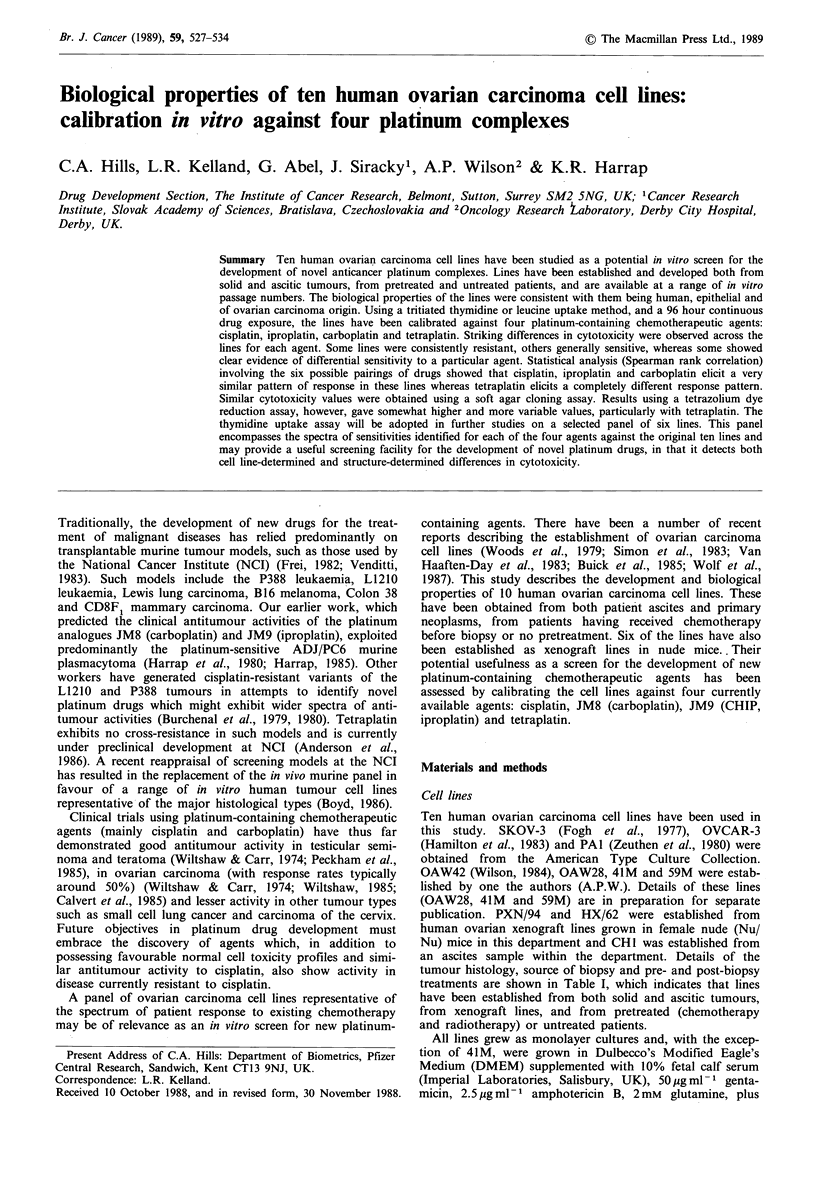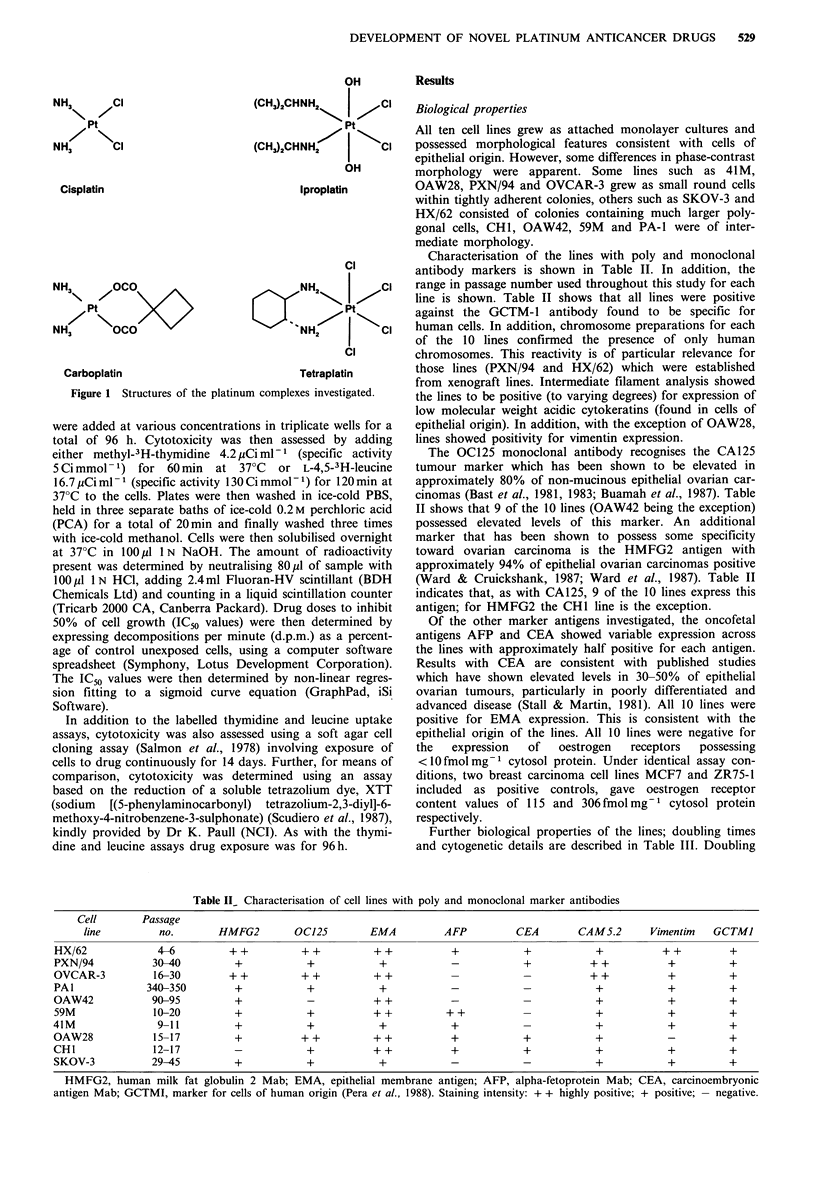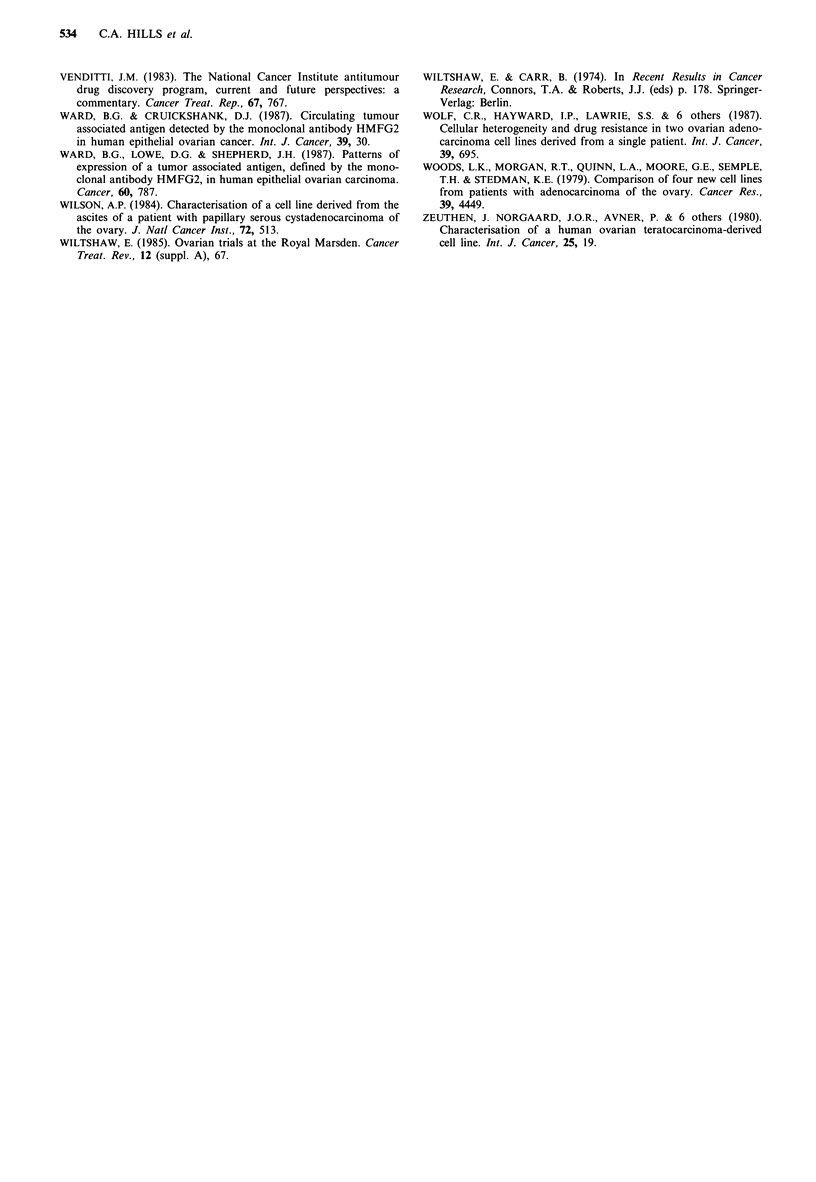Abstract
Ten human ovarian carcinoma cell lines have been studied as a potential in vitro screen for the development of novel anticancer platinum complexes. Lines have been established and developed both from solid and ascitic tumours, from pretreated and untreated patients, and are available at a range of in vitro passage numbers. The biological properties of the lines were consistent with them being human, epithelial and of ovarian carcinoma origin. Using a tritiated thymidine or leucine uptake method, and a 96 hour continuous drug exposure, the lines have been calibrated against four platinum-containing chemotherapeutic agents: cisplatin, iproplatin, carboplatin and tetraplatin. Striking differences in cytotoxicity were observed across the lines for each agent. Some lines were consistently resistant, others generally sensitive, whereas some showed clear evidence of differential sensitivity to a particular agent. Statistical analysis (Spearman rank correlation) involving the six possible pairings of drugs showed that cisplatin, iproplatin and carboplatin elicit a very similar pattern of response in these lines whereas tetraplatin elicits a completely different response pattern. Similar cytotoxicity values were obtained using a soft agar cloning assay. Results using a tetrazolium dye reduction assay, however, gave somewhat higher and more variable values, particularly with tetraplatin. The thymidine uptake assay will be adopted in further studies on a selected panel of six lines. This panel encompasses the spectra of sensitivities identified for each of the four agents against the original ten lines and may provide a useful screening facility for the development of novel platinum drugs, in that it detects both cell line-determined and structure-determined differences in cytotoxicity.
Full text
PDF







Selected References
These references are in PubMed. This may not be the complete list of references from this article.
- Alley M. C., Scudiero D. A., Monks A., Hursey M. L., Czerwinski M. J., Fine D. L., Abbott B. J., Mayo J. G., Shoemaker R. H., Boyd M. R. Feasibility of drug screening with panels of human tumor cell lines using a microculture tetrazolium assay. Cancer Res. 1988 Feb 1;48(3):589–601. [PubMed] [Google Scholar]
- Anderson W. K., Quagliato D. A., Haugwitz R. D., Narayanan V. L., Wolpert-DeFilippes M. K. Synthesis, physical properties, and antitumor activity of tetraplatin and related tetrachloroplatinum(IV) stereoisomers of 1,2-diaminocyclohexane. Cancer Treat Rep. 1986 Aug;70(8):997–1002. [PubMed] [Google Scholar]
- Bast R. C., Jr, Feeney M., Lazarus H., Nadler L. M., Colvin R. B., Knapp R. C. Reactivity of a monoclonal antibody with human ovarian carcinoma. J Clin Invest. 1981 Nov;68(5):1331–1337. doi: 10.1172/JCI110380. [DOI] [PMC free article] [PubMed] [Google Scholar]
- Buamah P. K., Cornell C., Skillen A. W., Cantwell B. M., Harris A. L. Initial assessment of tumor-associated antigen CA-125 in patients with ovarian, cervical, and testicular tumors. Clin Chem. 1987 Jul;33(7):1124–1125. [PubMed] [Google Scholar]
- Buick R. N., Pullano R., Trent J. M. Comparative properties of five human ovarian adenocarcinoma cell lines. Cancer Res. 1985 Aug;45(8):3668–3676. [PubMed] [Google Scholar]
- Burchenal J. H., Irani G., Kern K., Lokys L., Turkevich J. 1,2-Diaminocyclohexane platinum derivatives of potential clinical value. Recent Results Cancer Res. 1980;74:146–155. doi: 10.1007/978-3-642-81488-4_19. [DOI] [PubMed] [Google Scholar]
- Burchenal J. H., Kalaher K., Dew K., Lokys L. Rationale for development of platinum analogs. Cancer Treat Rep. 1979 Sep-Oct;63(9-10):1493–1498. [PubMed] [Google Scholar]
- Calvert A. H., Harland S. J., Newell D. R., Siddik Z. H., Harrap K. R. Phase I studies with carboplatin at the Royal Marsden Hospital. Cancer Treat Rev. 1985 Sep;12 (Suppl A):51–57. doi: 10.1016/0305-7372(85)90018-0. [DOI] [PubMed] [Google Scholar]
- Fogh J., Fogh J. M., Orfeo T. One hundred and twenty-seven cultured human tumor cell lines producing tumors in nude mice. J Natl Cancer Inst. 1977 Jul;59(1):221–226. doi: 10.1093/jnci/59.1.221. [DOI] [PubMed] [Google Scholar]
- Frei E., 3rd The National Cancer Chemotherapy Program. Science. 1982 Aug 13;217(4560):600–606. doi: 10.1126/science.7046055. [DOI] [PubMed] [Google Scholar]
- Hamilton T. C., Young R. C., McKoy W. M., Grotzinger K. R., Green J. A., Chu E. W., Whang-Peng J., Rogan A. M., Green W. R., Ozols R. F. Characterization of a human ovarian carcinoma cell line (NIH:OVCAR-3) with androgen and estrogen receptors. Cancer Res. 1983 Nov;43(11):5379–5389. [PubMed] [Google Scholar]
- Harrap K. R. Preclinical studies identifying carboplatin as a viable cisplatin alternative. Cancer Treat Rev. 1985 Sep;12 (Suppl A):21–33. doi: 10.1016/0305-7372(85)90015-5. [DOI] [PubMed] [Google Scholar]
- Hill B. T. In vitro screening of new drugs and analogues--specificity and selectivity. Cancer Treat Rev. 1987 Dec;14(3-4):197–202. doi: 10.1016/0305-7372(87)90008-9. [DOI] [PubMed] [Google Scholar]
- Kelland L. R., Burgess L., Steel G. G. Characterization of four new cell lines derived from human squamous carcinomas of the uterine cervix. Cancer Res. 1987 Sep 15;47(18):4947–4952. [PubMed] [Google Scholar]
- Makin C. A., Bobrow L. G., Bodmer W. F. Monoclonal antibody to cytokeratin for use in routine histopathology. J Clin Pathol. 1984 Sep;37(9):975–983. doi: 10.1136/jcp.37.9.975. [DOI] [PMC free article] [PubMed] [Google Scholar]
- Mosmann T. Rapid colorimetric assay for cellular growth and survival: application to proliferation and cytotoxicity assays. J Immunol Methods. 1983 Dec 16;65(1-2):55–63. doi: 10.1016/0022-1759(83)90303-4. [DOI] [PubMed] [Google Scholar]
- Peckham M. J., Horwich A., Brada M., Drury A., Hendry W. F. cis-Diammine-1, 1-cyclobutane dicarboxylate platinum II (carboplatin) in the treatment of testicular germ-cell tumours: a preliminary report. Cancer Treat Rev. 1985 Sep;12 (Suppl A):101–110. doi: 10.1016/0305-7372(85)90025-8. [DOI] [PubMed] [Google Scholar]
- Ruben R. L., Neubauer R. H. Semiautomated colorimetric assay for in vitro screening of anticancer compounds. Cancer Treat Rep. 1987 Dec;71(12):1141–1149. [PubMed] [Google Scholar]
- Salmon S. E., Hamburger A. W., Soehnlen B., Durie B. G., Alberts D. S., Moon T. E. Quantitation of differential sensitivity of human-tumor stem cells to anticancer drugs. N Engl J Med. 1978 Jun 15;298(24):1321–1327. doi: 10.1056/NEJM197806152982401. [DOI] [PubMed] [Google Scholar]
- Shoemaker R. H., Wolpert-DeFilippes M. K., Kern D. H., Lieber M. M., Makuch R. W., Melnick N. R., Miller W. T., Salmon S. E., Simon R. M., Venditti J. M. Application of a human tumor colony-forming assay to new drug screening. Cancer Res. 1985 May;45(5):2145–2153. [PubMed] [Google Scholar]
- Simon W. E., Albrecht M., Hänsel M., Dietel M., Hölzel F. Cell lines derived from human ovarian carcinomas: growth stimulation by gonadotropic and steroid hormones. J Natl Cancer Inst. 1983 May;70(5):839–845. [PubMed] [Google Scholar]
- Taylor-Papadimitriou J., Peterson J. A., Arklie J., Burchell J., Ceriani R. L., Bodmer W. F. Monoclonal antibodies to epithelium-specific components of the human milk fat globule membrane: production and reaction with cells in culture. Int J Cancer. 1981 Jul 15;28(1):17–21. doi: 10.1002/ijc.2910280104. [DOI] [PubMed] [Google Scholar]
- Twentyman P. R., Luscombe M. A study of some variables in a tetrazolium dye (MTT) based assay for cell growth and chemosensitivity. Br J Cancer. 1987 Sep;56(3):279–285. doi: 10.1038/bjc.1987.190. [DOI] [PMC free article] [PubMed] [Google Scholar]
- Venditti J. M. The National Cancer Institute antitumor drug discovery program, current and future perspectives: a commentary. Cancer Treat Rep. 1983 Sep;67(9):767–772. [PubMed] [Google Scholar]
- Ward B. G., Cruickshank D. J. Circulating tumor-associated antigen detected by the monoclonal antibody HMFG2 in human epithelial ovarian cancer. Int J Cancer. 1987 Jan 15;39(1):30–33. doi: 10.1002/ijc.2910390107. [DOI] [PubMed] [Google Scholar]
- Ward B. G., Lowe D. G., Shepherd J. H. Patterns of expression of a tumor associated antigen, defined by the monoclonal antibody HMFG2, in human epithelial ovarian carcinoma. Comparison with expression of the HMFG1, AUA1 and F36/22 antigens. Cancer. 1987 Aug 15;60(4):787–793. doi: 10.1002/1097-0142(19870815)60:4<787::aid-cncr2820600414>3.0.co;2-m. [DOI] [PubMed] [Google Scholar]
- Wilson A. P. Characterization of a cell line derived from the ascites of a patient with papillary serous cystadenocarcinoma of the ovary. J Natl Cancer Inst. 1984 Mar;72(3):513–521. [PubMed] [Google Scholar]
- Wiltshaw E. Ovarian trials at the Royal Marsden. Cancer Treat Rev. 1985 Sep;12 (Suppl A):67–71. doi: 10.1016/0305-7372(85)90020-9. [DOI] [PubMed] [Google Scholar]
- Wolf C. R., Hayward I. P., Lawrie S. S., Buckton K., McIntyre M. A., Adams D. J., Lewis A. D., Scott A. R., Smyth J. F. Cellular heterogeneity and drug resistance in two ovarian adenocarcinoma cell lines derived from a single patient. Int J Cancer. 1987 Jun 15;39(6):695–702. doi: 10.1002/ijc.2910390607. [DOI] [PubMed] [Google Scholar]
- Woods L. K., Morgan R. T., Quinn L. A., Moore G. E., Semple T. U., Stedman K. E. Comparison of four new cell lines from patients with adenocarcinoma of the ovary. Cancer Res. 1979 Nov;39(11):4449–4459. [PubMed] [Google Scholar]
- van Haaften-Day C., Russell P., Rugg C., Wills E. J., Tattersall M. H. Flow cytometric and morphological studies of ovarian carcinoma cell lines and xenografts. Cancer Res. 1983 Aug;43(8):3725–3731. [PubMed] [Google Scholar]


